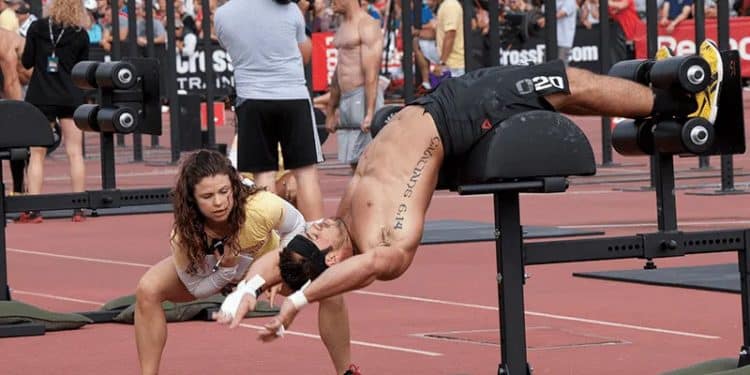The glute-hamstring developer is one of the most effective training tools for building a strong, muscular posterior chain and midline. While the GHD was originally designed to work the glutes, hamstrings, and lower back, exercisers have found a way to improve their core strength using this machine.
The GHD sit-up entered the mainstream after it became a part of popular CrossFit workouts like Mr. Joshua, Jorge, and Wet Noodle. Yes, CrossFit has a workout called ‘Wet Noodle,’ and it involves training with a partner. Go figure.
Initially, critiques argued that GHD sit-ups put more tension on the hip flexors and didn’t work the abominable muscles to the same degree as exercises such as crunches, sit-ups, and leg raises. However, these apprehensions have since been put to rest, as this exercise is now part of a growing number of ab training regimens.
Most beginners shy away from the GHD sit-up the moment they see someone do this exercise with a full range of motion. Let’s be honest; falling back while seated on a three to four feet high bench can be intimidating. However, most people get over this fear after a few goes on the GHD machine.
The GHD sit-up is one of the best exercises to build chiseled abs and develop a strong core, which can improve your overall functionality and translate to better performance in compound exercises, such as the squat, deadlift, and overhead press.
In this article, we dive deep into the GHD sit-up, including how to perform it with the correct form, its muscles worked, benefits, most common mistakes, and variations and alternatives. So, buckle up.
Level Up Your Fitness: Join our 💪 strong community in Fitness Volt Newsletter. Get daily inspiration, expert-backed workouts, nutrition tips, the latest in strength sports, and the support you need to reach your goals. Subscribe for free!
What is a GHD Sit-Up?

The GHD sit-up is a dynamic exercise that can improve your core stabilization, strength, and mobility. Unlike crunches, GHD sit-ups don’t involve trunk flexion. Instead, this exercise works your core through a static contraction.
This exercise involves performing sit-ups on a GHD machine. You will use your upper legs during the eccentric and concentrics motions.
Since the GHD sit-up involves a much bigger range of motion than the conventional sit-up, it results in much greater core stimulation. Many beginners report having a sore midsection for a week after performing this exercise.
Performing the GHD sit-ups requires a decent amount of upper body, hip flexor, hip, and overhead mobility. That said, making this exercise a constant in your training regimen can also improve your mobility over time.
How To Do a GHD Sit-Up
This is how to perform the GHD sit-up with a picture-perfect form:
Step 1: Adjust the Foot Pad
Start by adjusting the foot pad so your glutes are off the hip pad at the starting position. Ensure you secure the locks to avoid falling off the machine during an intense rep. Avoid setting the foot pad too close to the hip pad, as it can strain your spine during eccentrics (lowering motion).
Pro Tip: You should note the position of the pads if you train at a commercial gym. Experimenting with the settings every time can take up a lot of time.
Step 2: Get Into Position
Mount the GHD machine, secure your feet between the foot pads, and sit on the edge of the butt pad. The bottom of your glutes should be on the edge of the pad. Extend your arms so they are parallel to the floor. Extend your knees at the starting position. Keep your back neutral throughout the range of motion.
Pro Tip: Performing this exercise with bended knees will eliminate your hip flexors from the movement and put tension on your hamstrings.
Step 3: Begin the Decent
Brace your core, pull in your belly, and initiate the movement by leaning back. Keep your knees extended and contract your quads, glutes, and core as you lower your torso toward the floor. Move your arms overhead simultaneously.
Pro Tip: Avoid trying to control eccentrics. There is a time and place for slow negatives. This is not one of them. Maintaining a steady pace during the eccentric phase will provide you with the momentum needed to rise out of the hole.
Step 4: Touch the Floor
At the bottom of the range of motion, your upper body should be almost perpendicular to the floor, and your fingers should brush the floor.
Pro Tip: It might not be possible for shorter folks to touch the floor at the bottom. Nonetheless, ensure that your body is fully extended.
Step 5: Return
Contract your quads, hip flexors, glutes, and abs to return to the starting position. Throw your arms forward to generate momentum and get out of the hole. Repeat for the recommended repetitions.
Pro Tip: Drive your ankles into the top pad to generate force during the concentric phase. Make this exercise more challenging by avoiding momentum.
GHD Sit-Up Tips
- Beginners should initially limit their range of motion on this exercise. Lower yourself until your body is parallel to the floor. Break parallel only after you have developed the requisite core strength.
- Advanced exercise can challenge themselves by wearing a weighted vest or holding onto a kettlebell, dumbbell, or weight plate.
- You must focus on your breathing to maximize the results. Take in a deep breath at the top. Hold it during eccentrics and exhale sharply during concentrics.
- Keep your head neutral throughout the exercise. Throwing your head forward and back can cause neck sprains.
- It is common for beginners to experience ab cramps while performing this exercise. Discontinue the exercise, dismount the machine, and stretch out your abs if it happens to you.
Muscles Worked During GHD Sit-Up
The GHD sit-up works the following muscles:
Abs
The GHD sit-up primarily works the rectus abdominis, which is popularly known as the six-pack. It also strengthens the transverse abdominis, which wraps around your trunk and provides stability.
Hip Flexors
Hip flexors run along the front of your upper thigh. The psoas major and the iliacus are the primary hip flexor muscles responsible for flexing the hip during the upward phase of the sit-up.
Glutes
Glutes help extend your hips and play a vital role in stabilizing your body during the GHD sit-up. They also help you power out of the bottom of the sit-up.
Obliques
This exercise also works the internal and external obliques, which are located on the sides of the abdomen. These muscles help stabilize the trunk and assist spinal flexion during this exercise.
Lower Back
The erector spinae, also known as the lower back, prevents excessive spinal arching during the eccentric phase of the movement. It helps keep your spine neutral. You might experience lower back strain if you overextend your back at the bottom of the movement.
Quadriceps
Since you will keep your knees locked out during this exercise, your quads will jump into action during the eccentric and concentric phases. They will help you power through the movement and stabilize your core. You might also experience a little hamstring engagement during concentrics.
Benefits of GHD Sit-Up
Adding the GHD sit-up to your training regimen has the following advantages:
Builds a Strong and Chiseled Midline
GHD sit-ups work your core muscles through an extended range of motion, helping build a stronger core. Once at the bottom of the range of motion, you must rely on your midsection to return to the starting position. Only a few other exercises can match the demand the GHD sit-ups put on your midsection.
Performing three to five sets of 15 to 20 reps of this exercise twice weekly while following a balanced diet can help you build magazine-cover-worthy abs. That said, you must use the GHD sit-up variations and alternatives mentioned in this article to ensure overall core development.
Improves Your Hip Flexor Strength
Hip flexors are some of the most important but overlooked muscles. As the name suggests, these muscles are responsible for flexing the hips, i.e., bringing the knee closer to the chest. The hip flexors are responsible for basic movements like walking, running, jumping, and climbing stairs.
They are also crucial for your posture, core stability, balance, athletic performance, and lower body flexibility. Tight and weak hip flexor muscles can lead to lower back pain and injuries.
Boosts Mobility
The GHD sit-up involves an extensive range of motion, which can improve your flexibility and mobility. People with limited mobility might have trouble performing this exercise initially. These folks should begin with partial reps and slowly move their way up.
Level Up Your Fitness: Join our 💪 strong community in Fitness Volt Newsletter. Get daily inspiration, expert-backed workouts, nutrition tips, the latest in strength sports, and the support you need to reach your goals. Subscribe for free!
Do not use poor mobility as an excuse to skip the GHD sit-up. Instead, look at it as an opportunity to fix your weakness. This exercise also improves your overhead mobility, which is a problem area for most folks with a sedentary lifestyle.
Enhances Functional Fitness
GHD sit-ups are a functional movement, the benefits of which can carry over to other exercises, such as the overhead squat, snatch, and clean and jerk. Plus, it can also improve your day-to-day functioning by improving your core strength and conditioning.
Improves Your Posture
People that spend most of their day hunched over a computer or smartphone tend to develop a rounded back or shoulders. Adding GHD sit-ups to your exercise regimen can help rectify this problem.
Common Mistakes While Performing GHD Sit-Up
Avoid committing the following mistakes to limit your risk of injury and maximize your gains:
Trying To Follow a Full Range of Motion on the First Attempt
The GHD sit-up is a demanding exercise. Chances are, no other exercise you have ever done engages your core like the GHD sit-up. This exercise has a steep learning curve.
Take it slow. Beginners should begin with partials and transition to the full range of motion after they have built the requisite core strength. Have a spotter on standby in case you fail at the bottom of the movement.
Not Using Your Legs
Although the GHD sit-up is an ab exercise, you should not flex your spine as you do in the crunches to achieve optimal abdominal contraction. Drive your ankles into the top foot pad to power the concentrics. Restricting lower body engagement will limit your performance on this exercise. You should expect sore hip flexors the new day after doing a high-volume GHD sit-up workout.
Doing Too Much Too Soon
Newbies must take it slow on the GHD machine. Begin with doing 10-15 reps for two sets. Don’t try to complete a CrossFit Hero workout on the GHD machine on your first day at the gym. Progressive overload is the key to building strength and muscle mass. It is called a ‘progressive’ overload for a reason. Overstretching yourself on the GHD sit-up can cause excruciating soreness and increase your risk of injury.
Variations of GHD Sit-Up
Use these GHD sit-up variations to add variety to your workouts and ensure overall development:
GHD Sit-Up Controlled Eccentrics
The set-up of this exercise is the same as the conventional GHD sit-up. The difference lies in the lowering movement. The standard GHD sit-ups involve quick eccentrics. However, in this variation, the eccentrics are much more controlled. Spend three to five seconds on the lowering motion to maximize core and hip flexor engagement.
Pro Tip: You can have your partner help you through the concentric phase of this lift. However, you must ensure you are going as slowly as possible on the eccentrics. Hold onto a weight plate to make this exercise more challenging.
GHD Sit-Up Iso-Hold
This exercise begins like the conventional GHD sit-up. Get into the position and slowly lower yourself toward the ground by leaning backward. Stop when your body is in a straight line and is parallel to the floor. Hold this position for 30-60 seconds. Dimount the GHD machine. Repeat for recommended sets.
Pro Tip: Keep your head neutral during the isometric hold. Tucking your chin into your upper chest or letting your head drop back can sprain your neck.
GHD Side Crunch
Obliques are often overlooked in an abdominal training routine. You must train these muscles to build a stronger core and improve your midsection aesthetics.
How To:
- Adjust the foot pads so your hips rest on top of the pads.
- Mount the GHD machine and grab the left handle for support.
- Turn to your side so your right shoulder is facing the ceiling. The side of your left hip should be on the left pad, and your knees should be stacked.
- Secure your lower foot between the foot pads and place your right foot on top of the pads.
- Your body should be in a straight line and parallel to the floor at the starting position.
- Perform a side crunch and lower your torso as low toward the floor as possible.
- Return to the starting position.
- Repeat for recommended reps before switching sides.
Pro Tip: Avoid breaking parallel during the exercise, as it can remove tension from your working side. Keep the reps slow and controlled to focus on your target muscles.
GHD Russian Twist
The GHD Russian Twist is more difficult than the standard variation done on the floor. This exercise involves greater core engagement as you must simultaneously stabilize your hips and core. Plus, you’ll lean back a little more than in the conventional variation.
How To:
- Set the foot pads of the GHD machine in the GHD sit-up position. Your glutes should be off the top of the pad.
- Position the top of your hamstrings on the edge of the hip pad.
- Keeping your legs extended, lean back while maintaining a neutral spine until your torso is almost parallel to the floor.
- While maintaining a neutral head position and eyes locked forward, extend your arms straight in front of you.
- Turn to your left as far as possible.
- Return to the starting position.
- Repeat on the right side.
- Alternate between sides for the recommended reps.
Pro Tip: Experienced lifters can hold onto a weight plate or kettlebell while performing this exercise. Breathe out and contract your obliques at the static contraction point on either side to ensure maximum muscle stimulation.
Alternatives of GHD Sit-Up
Here are the best alternatives to the GHD sit-up:
Reverse Crunch
The reverse crunch is an excellent exercise to work the middle and lower abs, which are generally a lagging muscle group for most people.
How To:
- Lie on your back on the floor.
- Place your hands under your hips for leverage.
- Bend your knees and lift your feet off the floor. This will be your starting position.
- Contract your core and pull your thighs to your chest.
- Pause at the top of the motion.
- Return to the starting position.
- Repeat for reps.
Pro Tip: Work your abs through a more extended range of motion by extending your legs at the bottom. Your body should be in a straight line at this position.
Check out our complete reverse crunch guide here!
Hanging Leg Raise
The hanging leg raise is one of the best isolation exercises to build a strong, chiseled midsection. However, you might need some time to drill the movement and avoid swinging back and forth excessively during the exercise.
How To:
- Grab a pull-up bar with a shoulder-wide overhand grip.
- Your body should be in a straight line at the starting position.
- Contract your lats, glutes, and abs, and raise your legs toward the ceiling without bending your knees.
- Your legs should be parallel to the floor at the top of the range of motion. Pause and contract your abs at this position.
- Slowly return to the starting position.
- Repeat for reps.
Pro Tip: Grab the overhead bar with a full grip. Avoid using a false (thumbless) grip, as your grip strength is more likely to give up before your abs.
Check out our complete hanging leg raise guide here!
V-Up
This exercise will not only help you build a shredded core, but it will also improve your hand-eye coordination.
How To:
- Lie supine on the floor.
- Extend your arms overhead.
- Lift your legs, head, and arms a few inches off the floor. This will be your starting position.
- Lift your legs toward the ceiling and perform a sit-up. Simultaneously bring your hands toward your feet in a sweeping motion.
- Pause and contract your abs at this position.
- Return to the starting position.
- Rinse and repeat.
Pro Tip: Beginners can begin this exercise while limiting the movement to their legs and torso. Cross your arms in front of your chest. Add your arms when you are comfortable with the exercise mechanics.
Check out our complete v-up guide here!
FAQs
Why does the GHD sit-up cause back pain?
People that overextend their back at the bottom of the range of motion while bending their knees are more likely to experience back pain while performing the GHD sit-up. This position results in an overextension of the lumbar spine while the psoas compresses the spine, resulting in back pain.
How To Program the GHD Sit-Up into Your Workout
You should perform three to five sets of 10-15 reps of GHD sit-ups to build a chiseled midsection and improve your core strength. Endurance athletes, CrossFitters, and Olympic weightlifters should do 15-plus reps on each set to build a bullet-proof core and boost their performance.
Who Should Perform GHD Sit-Up?
CrossFitters, Olympic weightlifters, Strongmen and hybrid athletes, and bodybuilders can all benefit from the GHD sit-up. Furthermore, hobbyist exercisers should also add this exercise to their training regimen as it can improve their overall functionality.
Wrapping Up
The GHD sit-up is an excellent exercise to strengthen the core and build an explosive midline. GHD sit-ups combined with a balanced, nutrient-dense diet can help you shed the excess belly fat and build a diced six-pack.
This article covers everything you need to know to make the most out of this exercise. If you don’t have access to a GHD bench at your gym, you can stack a flat bench on a couple of aerobic steps and ask your training partner to sit on your shins while you perform the sit-ups. Furthermore, use the variations and alternatives explained above to spice up your workouts. Best of luck!
Interested in measuring your progress? Check out our strength standards for Overhead Squat, Sit Ups, Clean, and more.











